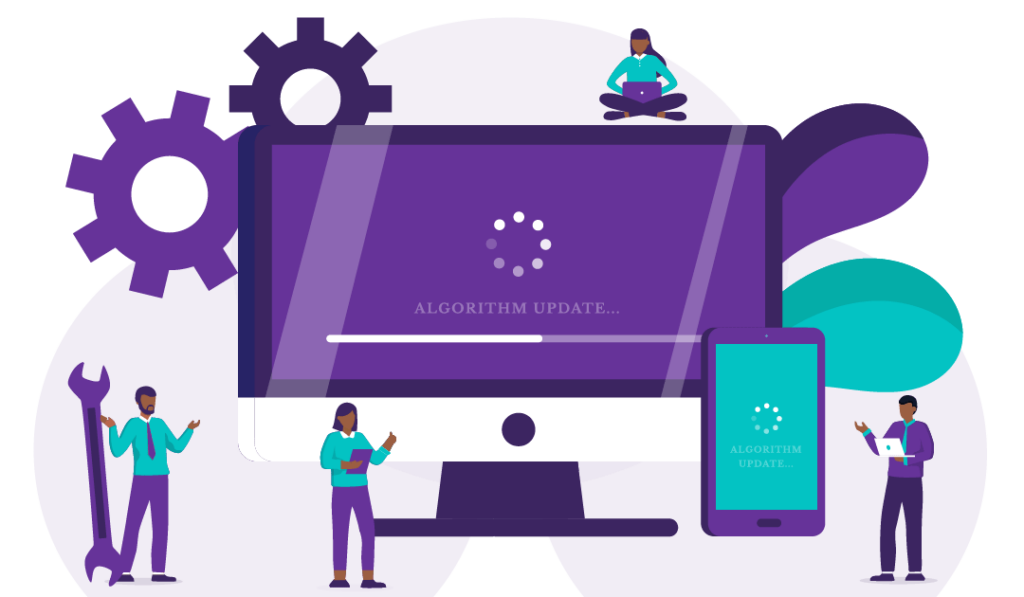On 4 May 2020, Google confirmed the May 2020 Core Update began rolling out. Now that update’s been and gone, here’s what you need to know about the impact it continues to have on Google search. Read this article or listen to the audio.
Topics covered
How many times does Google change their algorithm?

Google changes its search algorithm once or twice a day. On average, it updates the algorithm around 500-600 times a year.
However, most of these updates are minor tweaks of the algorithm and Google usually doesn’t release any details about them.
Google only makes big or broad changes to the algorithm a few times a year. The bigger changes are called ‘core updates’ and the Google team usually announces when core updates are rolling out because they’re often more noticeable.
What is a broad core algorithm update?

Sometimes Google releases algorithm updates that target specific issues. For instance, Penguin aimed to combat link spam.
Broad core algorithm updates are updates that affect search results more broadly because they alter the main search algorithm. Typically a broad core algorithm update will be an adjustment of the weighting or order of importance of one or more search ranking factors. (There are over 200 ranking factors that Google uses to decide where to rank a given web page in the search results for each search query.)
What does Google’s May 2020 Core Update mean for businesses?

Unlike big named updates, like BERT and Penguin, Google didn’t release specific details about the impacts of the May 2020 Core Update. However, in 2020 Google was heavily focussed on improving the search experience for its users. Websites that lost traffic as a result of this update tended to be those that were slow or had lots of ads etc. Subsequent updates (e.g. in June 2021) modified the Google algorithm so it more heavily prioritises sites that pass all the Core Web Vitals tests listed in Google Search Console. What that basically means is your site must provide a good experience for your audience if you want to rank well in organic search.
What do you need to do to maintain or improve your search visibility and rankings in the wake of the May 2020 Google algorithm update?
If you notice a dip in your search rankings in the wake of any Google algorithm update, here’s what you should do:
1. Do an SEO audit.
Do an SEO audit of your site to check for any issues that could be negatively impacting your search rankings and traffic. The sorts of things that are picked up by an SEO audit are not impacted by algorithm updates, but if you’re going to do any work to optimise your site for search engines, you’re better off building a good foundation so you get the best return on your investment (whether that investment is in time, money or other resources).
2. Upgrade your top content
Take a look at the top 10-20 pages (including blog posts) on your site and critically assess them in terms of readability, how comprehensively they cover the topic, how engaging they are and how well they’re optimised for search engines. Also look at how well optimised the SEO particulars (SEO title, meta description and slug) are for search engines and click-through rates. If you can see anything that could be improved, make those improvements. Maybe there are some new statistics or research you could reference. Maybe there’s a new frequently searched question you could answer as a new section. Maybe a lower-priority keyword has become more popular than one of the keywords you used frequently throughout the piece and substituting them could boost your rankings.

3. Review your content promotion strategy.
Revisit your content promotion strategy. Could you promote your content more heavily or in a different way to boost non-search (organic or paid) traffic?
4. Create more content.
Consider creating more content. Perhaps now is the time to try some of those new content ideas you’ve had percolating in the back of your brain. And now’s a good time to see whether any of your competitors experienced a surge in traffic after the update. (If they did, analyse their content for lessons you can take on board. A competitor SEO analysis can really help with this.) Maybe you could test some ideas on social media or via your email list to see if they’re popular with your audience without investing too much in content. If they’re popular, you could then create more detailed content like blog posts, videos, podcasts etc. The goal here is to find some ideas that will provide great value to your target market and which will rank better in the newly modified algorithm. Unfortunately, testing and analysing your competitors are the only ways you’ll be able to tell whether something might rank better after the algorithm update.
TLDR: What you need to know in the wake of the May 2020 Google Core Update
The May 2020 Core Update was a basic update that seemed to more strongly affect sites that didn’t provide a good experience to their users. To ensure you’re not penalised by the algorithm updates made at that time, follow content best practices. By creating high-quality content that provides value to your audience, you’ll publish content that’s far less likely to be negatively affected by core updates.

